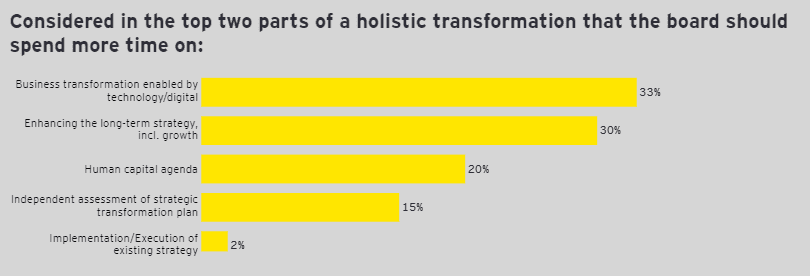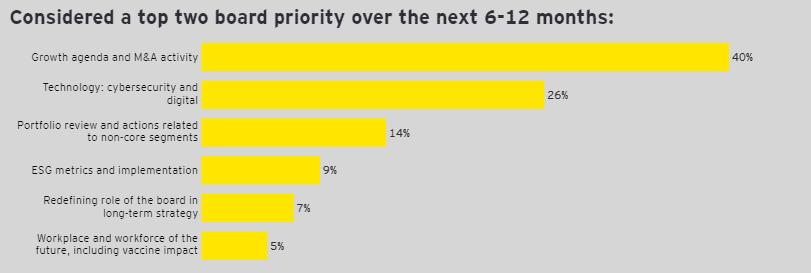How to be an effective independent lead director and the role of the board in strategic transformations.
In brief:
- Boards have had to react to strategic and operational changes and prioritize short-term disruptions and long-term changes at an unparalleled pace.
- Having one-on-one calls with board members outside of regularly scheduled meetings can help make everyone feel more connected.
We recently brought together 30 public company board members for a virtual discussion on how to be an effective independent lead director and the role of the board in strategic transformations. The roundtable was hosted by Sam Johnson, EY Americas Vice Chair, Markets & Accounts; Sanjay Ramaswamy, EY-Parthenon Americas Turnaround and Restructuring Strategy Leader; Steve Klemash, EY Americas Center for Board Matters Leader; and Gaurav Malhotra, EY Americas Reshaping Results & US Restructuring Leader.
COVID-19 impact and the role of the board
Since the declaration of a global pandemic 14 months ago, many organizations have had their resiliency tested, and they have been forced to address a multitude of topics sooner than otherwise required. Those topics ranged from liquidity preservation in the early days of the pandemic to redesigning the operating model for the future and pursuing a growth strategy for the business.
The pace at which boards and C-suite members have had to react to strategic and operational challenges has been unparalleled. Board members had to prioritize among short-term business disruptions and long-term transformational changes while also confirming that their commitments on critical pillars of environmental, social and governance (ESG) and diversity, equity, and inclusion (DE&I) were not compromised.

Board members not only shared their personal experiences and best practices on being effective board members but also discussed a variety of topics around strategic transformations such as 1) hallmarks of a holistic transformation, 2) balancing liquidity, leverage and long-term value, 3) core and non-core business segments, 4) views of an activist investor and 5) M&A activity.
It was clear from the discussion that many companies did an excellent job, and their boards were intently involved in navigating the challenges brought forth by the pandemic. They acted swiftly to fortify balance sheets, stabilize liquidity and focus on changing market dynamics. Board members did not get caught up in immediate storms and maintained their focus on long-term strategic issues, mid-and long-term risks and opportunities, and maximizing enterprise value through transactions.
Five steps for effective board leadership
The discussion was anchored by one seasoned executive’s journey from being a CEO to a board member and eventually a lead independent director. He provided insights about what he’s learned along the way and his five steps on what can make a lead director more effective.
1. Build transparency with the CEO
Always start board meetings with a session with the CEO. This is not only the best hour of the board meeting, but it tees up the real issues and opportunities the company has and also improves transparency and the relationship between the CEO and the board. As the lead director, have a one-on-one call with the CEO immediately following the board meeting to let him or her know how the session ended and how the later discussion went. Finally, one-on-one calls with board members outside of regularly scheduled meetings can help make everyone feel more connected.
2. Promote participation from all board members
During the executive session at the end of each board meeting, with the management team absent, query each board member for their views on management’s focus areas. It’s important to cultivate an environment with the board that allows for (and requires) input from each board member so that the diversity of thoughts and opinions on the board is captured and considered.

3. Focus on risks to drive strategy at every board meeting
Set aside time in every board meeting to discuss risk and use that discussion to drive a conversation on strategy; discussions about risk often drive proactive decisions on strategy. Consider whether the management team should present four scenarios at the beginning of the year to keep the board focused on where things could go, rather than where they’re going. Lastly, for each topic on the agenda, ask, “How does this relate to strategy and, if not, should it be on the agenda?”
4. Get an external view and think like an activist
Invite an analyst or major investor to speak to the board. Board members often find such visits very helpful and fascinating. They allow the board to get a good sense of both positive and negative insights about the company, new opportunities and emerging trends. The board should focus on trends that have momentum and form a committee or committees around them to develop a playbook and response to what’s being done to address those trends. DE&I and ESG are perfect examples of this — they gained momentum, are now front-and-center on the board agenda and are here to stay.
5. Play a leading role in shaping the board agenda
Too often, board meetings are filled with content the management team spent weeks to prepare, and at the end of the session, there’s a gap between what was discussed and what the board wanted to hear. Have the management team prepare short briefing videos that are distributed prior to the board meeting to allow more time for decision-making and discussions about strategy during the meeting. Engage with management to plan the agenda, review materials received prior to the meeting and go over expected outcomes.

What’s on board members’ minds
Participants shared the following comments on how boards can increase their impact on the strategy and transformation agenda:
- The composition of your board matters — the diversity, who they are and what their perspective is. We need rich and diverse perspectives to keep moving forward.
- Work with the management team to look beyond the pandemic disruption and day-to-day crisis management and towards longer-term transformation.
- Aligning the human capital strategy is one of the most critical and often overlooked components of a transformation.
- Confirm that boards have proper education regarding technology to be conversant on those things that will enable a successful transformation.
- The board should play the role of advocate and questioner to help management through crisis and changes in strategic vision.
- The board and management need to decide whether market-driven risks are really smoke or fire or smoke leading to fire.
- Strategic ideas are the seeds and the planning and execution are the water and the sun.
- Most strategies fail through execution, not through imagination. Boards should facilitate successful implementation of transformative initiatives.
- A board’s role is to influence the company’s decision, not just on the acquisition but also the integration.
Summary
Our recent virtual roundtable featured independent board leaders who discussed how boards can help companies as they consider key topics related to holistic transformations, creating long-term value, M&A and more.
The article was first published here.
Photo by Julien Flutto on Unsplash.

 5.0
5.0 





















